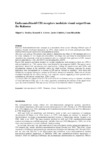Mostrar o rexistro simple do ítem
Endocannabinoid CB1 receptors modulate visual output from the thalamus
| dc.contributor.author | Dasilva, Miguel A. | |
| dc.contributor.author | Grieve, Kenneth | |
| dc.contributor.author | Cudeiro, Javier | |
| dc.contributor.author | Rivadulla, Casto | |
| dc.date.accessioned | 2015-04-28T11:52:08Z | |
| dc.date.available | 2015-04-28T11:52:08Z | |
| dc.date.issued | 2011-07-20 | |
| dc.identifier.citation | Dasilva MA, Grieve KL, Cudeiro J, Rivadulla C. Endocannabinoid CB1 receptors modulate visual output from the thalamus. Psychopharmacol. 2012;219:835-45. | es_ES |
| dc.identifier.uri | http://hdl.handle.net/2183/14459 | |
| dc.description.abstract | [Abstract] Rationale Endocannabinoids have emerged as a modulatory brain system affecting different types of synapses, broadly distributed throughout the CNS, which explain the diverse psychophysical effects observed following activation of the endocannabinoid system. Objectives and methods The present study aimed to characterize the effect of CB1-mediated activity in the visual thalamus. In vivo single-unit extracellular recordings were performed in anaesthetized adult pigmented rats, measuring visual and spontaneous activity, combined with application of CB1 receptor agonists (anandamide, 2-AG, and O2545) and one antagonist, AM251. Results CB1 receptors activation revealed two cellular populations, with excitatory effects on ∼28% of cells and inhibitory in ∼72%, actions which were blocked by the antagonist AM251. The agonist action significantly altered both spontaneous and visual activity, shifting the signal-tonoise ratio (S/N), with accompanying changes in the variability within the visual response. Increased responses by agonist application were accompanied by a decrease in S/N and an increase in variability, while those cells inhibited by the agonist showed an increase in S/N and a decrease in variability. There was no obvious correlation between the two effects and any other response property suggesting a more general role in modulating all information passing from LGN to cortex. Conclusions Our data support a role for CB1 at the level of the thalamus acting as a dynamic modulator of visual information being sent to the cortex, apparently maintaining the salience of the signal within upper and lower boundaries. This may account for some of the behavioral effects of cannabis. | es_ES |
| dc.description.sponsorship | The work was supported by MICINN (BFU2009-08169) and Xunta de Galicia (Consellería de Educación-2007/000140-0), Spain. M. Dasilva is a predoctoral fellow supported by the FPU program. | es_ES |
| dc.description.sponsorship | info:eu-repo/grantAgreement/MICINN/Programa Nacional de Investigación Fundamental/BFU2009-08169/ES/Papel De Las Conexiones Feedback En El Procesamiento Visual | |
| dc.language.iso | eng | es_ES |
| dc.publisher | Springer | es_ES |
| dc.relation.uri | http://dx.doi.org/10.1007/s00213-011-2412-3 | es_ES |
| dc.rights | "The final publication is avaliable al link.springer.com" | es_ES |
| dc.subject | Endocannabinoids | es_ES |
| dc.subject | dLGN | es_ES |
| dc.subject | Thalamus | es_ES |
| dc.subject | Vision | es_ES |
| dc.subject | Cannabinoids | es_ES |
| dc.subject | CB1 | es_ES |
| dc.title | Endocannabinoid CB1 receptors modulate visual output from the thalamus | es_ES |
| dc.type | info:eu-repo/semantics/article | es_ES |
| dc.rights.access | info:eu-repo/semantics/openAccess | es_ES |
Ficheiros no ítem
Este ítem aparece na(s) seguinte(s) colección(s)
-
GI-NEURO - Artigos [158]
-
INIBIC-NEURO - Artigos [48]






